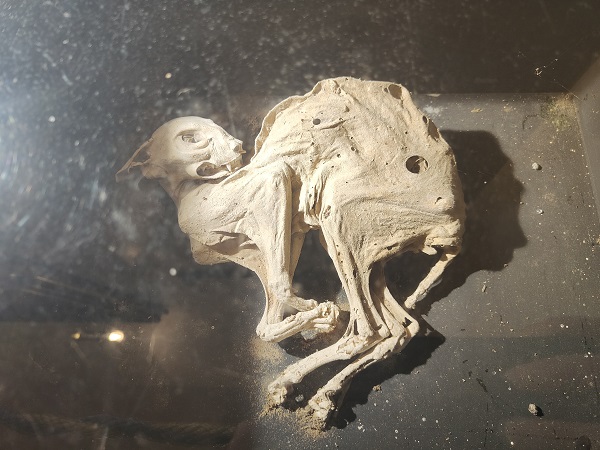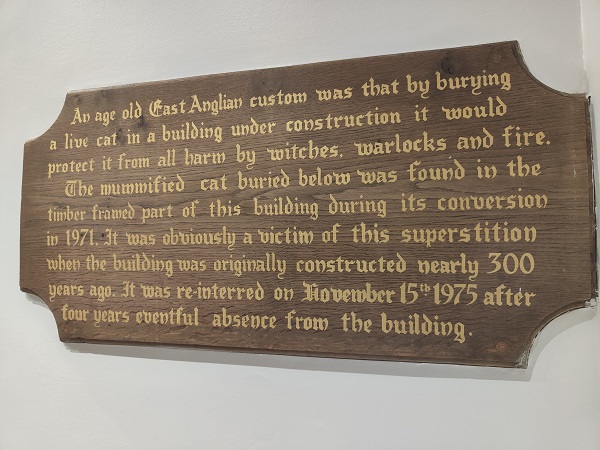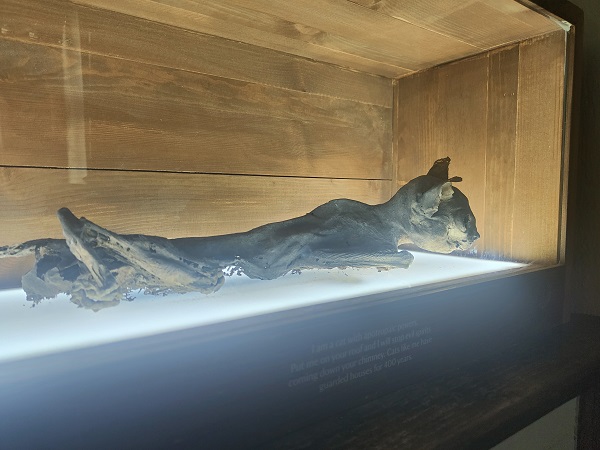What do Moyse’s Hall museum and The Nutshell pub in Bury St Edmunds have in common with the Guildhall in Lavenham and the Mill Hotel in Sudbury?
The answer: all four buildings are home to the same type of macabre-yet-intriguing attraction – mummified cats.
Their existence is no accident – and their geographic proximity to each other is no coincidence. It’s common to think of cats as being associated with witches – but these particular cats were no witches’ familiars…
Seventeenth-century superstitions
In the 17th century, Matthew Hopkins, the Witchfinder General (a title he most likely gave himself) ramped up paranoia levels across East Anglia. Born in Suffolk, he later moved to Manningtree in Essex, where he claimed to have overheard a group of women talking about their meetings with the Devil.
Puritanical by nature, he took it upon himself to hunt out and prosecute witches (for a small fee, of course). It is believed that between 1644 and 1646 alone, Hopkins and his partner John Stearne were responsible for the deaths of around 300 women accused of witchcraft.
The public were understandably frightened – not just of the prospect of witches, but also of other supernatural beings. But what could they do to protect themselves?
Faith in felines
One method of protection – of which evidence has been found dating back as far as the thirteenth century – was to place a cat under the floor, within the walls or in the roof of a house as it was being built. These cats were not always dead at the time.
The idea was that the cat would bring good luck, ward off any evil spirits (including witches and their familiars, which could take on a human or animal form) and prevent house fires.
But why cats? Well, the belief was that cats had a sixth sense that could help them to sniff out the supernatural. People also believed that cats could continue to hunt after their death, protecting the home’s occupants for years to come.
If you want to see four examples in close proximity to each other, you can do a mini mummified cat tour in Suffolk, starting in Sudbury.
The Mill Hotel, Sudbury
We stopped at The Mill Hotel for a drink in its bar, where you can still see the mill wheel turning as a centrepiece to the room. The Domesday Book makes mention of a mill in Sudbury, which likely stood on the same site, but the oldest part of the current building dates back to around 1800.
When the building was converted into a hotel in 1971, the mummified body of a cat was discovered. After four years away from the building (I have no idea where) it was placed in a sunken glass case in the floor in the reception area.
Head through the main entrance and walk to the wall straight in front of you and you’ll see the cat’s hunched body, along with a plaque on the wall that explains its history.


The Guildhall, Lavenham
Just up the road from Sudbury, you’ll find the beautiful medieval market town of Lavenham (click here for reasons why you should visit). The Grade I-listed Guildhall is in the care of the National Trust and is home to Rameses, the next mummified cat on our list.
You’ll find him in the large downstairs room, encased in a box to the right of the fireplace. Lift up the hessian cloth to reveal him in all his glory – complete with his own automatic lighting. There’s very little information about him, except that he was discovered in a nearby roof during building work, but you’ll marvel at how well-preserved he is.

The Moggies of Moyses and more in Bury St Edmunds
Here in my home town of Bury St Edmunds you can find two examples of mummified cats in the town centre – and both in very different places.
Moyse’s Hall Museum houses a witchcraft display which features multiple locally-discovered mummified cats. If you like the gruesome and macabre, it’s definitely a place to visit: other exhibits include a gibbet cage and a book bound with the skin of William Corder, the Red Barn Murderer, as well as Corder’s scalp.
After that you may need a stiff drink: head to The Nutshell, which previously held the accolade of being Britain’s smallest pub. If you can squeeze inside you’ll notice the eclectic decor, including a ceiling lined with various foreign banknotes that have been collected over the years.
Suspended from the ceiling is “Fluffy”, as the 400-year-old mummified cat is known. Discovered behind the fireplace in 1935, it now hangs proudly above the bar to continue to ward off trouble.
If the history of witchcraft is your thing, or if you’re simply fascinated by the gruesome and macabre, these four buildings are within a 20-mile radius of each other so are easy to see in one trip. I’d love to hear if you have any similar displays where you live!